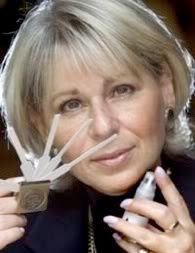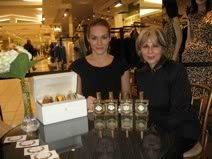 Thinking about perfumery I often contemplate on its evolution, the way it has progressed through the centuries from the simpler techniques to state-of-the-art methods that encompass analytical chemistry, synthesis and sophisticated technologies such as IFF's "Living Flower Technology"*. It never ceases to amaze me that men and women have gone thus far in their quest for the aromatic, the holy and the hedonic.
Thinking about perfumery I often contemplate on its evolution, the way it has progressed through the centuries from the simpler techniques to state-of-the-art methods that encompass analytical chemistry, synthesis and sophisticated technologies such as IFF's "Living Flower Technology"*. It never ceases to amaze me that men and women have gone thus far in their quest for the aromatic, the holy and the hedonic.And thus I often wonder what achievements should be salvaged in a time-capsule, like a project that could be sent to outer space, to get to know humanity's odoriferous achievements at a time when humanity might have ceased to exist altogether. Taking into consideration that the KEO satellite will launch in 2009 or 2010 with a mission to present Earth to humanity 50,000 years from now, when the satellite orbiting Earth will return, it seems like it is not too soon to think about.
So in our own small way, Dain from Lipstick Page and me brainstormed for a while on which scents would be worth salvaging for posterity's sake.
In a way it was like re watching Kubrik's 2001: A Space Odyssey: there is the profound awe for man's course through history and the sense of aporia on what will happen now that space has been invaded. That bone in the air travels through 4 dimensions and the fourth one is time itself...
My own criteria on this project were historically oriented: I concentrated on which compositions or techniques were evolutionary, providing something revolutionary at its time and influencing later developments. It does not mean that I consider the scents named the greatest of all time in their artistic merit or subjective beauty appreciation, but it does mean that I put faith in their importance as landmarks.
Without further ado here is my list, in chronological order:
1.The sacred Kyphi of Ancient Egyptians: a compound incense used in ancient Egypt for religious and medical purposes and referenced in The Pyramid Texts. Papyrus Harris I records the donation and delivery of herbs and resins for its manufacture in the temples under Ramses III for his afterlife. Instructions for its preparation and lists of ingredients are found among the wall inscriptions at the temples of Edfu and Dendera in upper Egypt. The term "kyphi" is Greek, a transcription of the ancient Egyptian term kp.t. The key ingredient featured in some recipes was spikenard, while apart from wine, honey and raisins there was cinnamon and cassia bark, aromatic rhizomes of cyperus and sweet flag, cedar , juniper berry, and resins and gums such as frankincense, myrrh, benzoin resin and mastic, as well as the mysterious aspalathos, a bush with bright yellow flowers still abundant in the Mediterranean. If anything it is proof of the sophisticated criterion by which the ancients composed their aromatic alloys.
2.Greek philosopher Theophrastus's "Enquiry into Plants: Books 6-9; Treatise on Odours": Although technically neither a composition nor a technique, it remains the first serious, epistemological treatise of plants and their properties, setting the path for herbalism and aromatherapy and influencing all consequent medieval science and alchemy. Nicknamed Theophrastus by Aristotle for his "divine way of expression" (this is what the name means in Greek), Tyrtamus became the father of Taxonomy and the propeller of alchemical investigation centuries later.
3.The distillation of rose by the Arabs: It was Ibn Sīnā, commonly known in English by the Latinized name Avicenna (Greek Aβιτζιανός), a Persian-speaking Iranian, Muslim polymath and the foremost physician and Islamic philosopher of his time that contributed to perfumery in an unexpected way. Up till the 10th century, the king of flowers, the rose, had been resisting methods of extracting its precious soul. Distillation became known, with Catalonian Arnald of Villanova's treatise being the first European one focusing on the method, because Avicenna had introduced steam distillation in Islam and through the Crusades the secrets of this civilization expanded into the Western World. Thus he produced essential oils of delicate plants that resisted other methods, attar of rose being one such essence. One is hard pressed to imagine modern perfumery without rose essence.
4.The traditional Eau de Cologne recipe: Kölnisch Wasser, as is its proper name in German, is an amazing survivor. Launched in the German town of Cologne in 1709 by Giovanni Maria Farina, an Italian perfumer from Santa Maria Maggiore Valle Vigezzo, Italy, it was inspired the odor of an Italian spring morning after the rain. The original recipe was used as a tonic as well as a fragrance, and Napoleon (along with composer R.Wagner) was a particular enthusiast of the Farina Eau de Cologne: he was said to use at least a bottle a day, often two, if one goes by his private correspondence.
Giovanni Maria Farina's formula has been produced in Cologne since 1709 by Farina Gegenüber without ever divulging the exact recipe. His shop at Obenmarspforten is today the world's oldest fragrance company. Other Colognes took the name yet smell different, such as the famous Cologne 4711, named after this location at the "Glockengasse No. 4711". In 1806, Jean Marie Joseph Farina, a grand grandnephew of Giovanni Maria Farina (1685-1766), opened a perfumery business in Paris which developed into Roger & Gallet, owner of the rights to Eau de Cologne Extra Vielle in contrast to the Original Eau de Cologne from Cologne.
5.Fougère Royale by Houbigant: Composed in 1882 it is arguably the first perfume to incorporate a synthetic ingredient: coumarin, a chemical compound (benzopyrone) which naturally occurs in many plants, such in the tonka bean, woodruff, mullein, and bison grass. Possessing a sweet pleasant aroma, it is readily recognised as the scent of newly-mown hay.
With Fougère Royale Houbigant intoduced the Fougère family of scents: a composition based on the juxtaposition of bergamot-lavender-coumarin and accounting for hundreds of fragrances on the market since, most notably in the men's end of the spectrum.
6.Chypre by Coty: Although Chypre is a classical age composition developed in ancient Cyprus and later popularised by the Romans, it took the genius of perfumer François Coty to re-introduce and streamline this old idea in 1917 into what eventually became the most intricate family in all perfumery. In a way, although it is a gem lost to the echo of centuries to come, it stands as the end of an era and the beginning of a new one: in many ways it conspired along with Jicky and Fougere Royale in jump starting the modern perfumery of the 20th century and placing a greater emphasis in the design of the fragrance (structure) as opposed to merely its texture (materials).
7.Chanel No.5: It is no accident that Chanel's No.5 is the perfume that even people completely unassociated with the noble sport of fragrance appreciation instantly recognise and fragrance loving neophytes take extra pains to come to terms with. The fragrance is a triumph of modern design, chemical innovation (although not the first one to use synthetically derived aldehydics, it was the first to make ample use of them) and of marketing strategy. It has become iconic and its status as a best-seller is never refuted. If only for its extreme popularity, even though arguably lots of people collect it rather than wear it, it is well worth its slot in this list of scents to salvage for posterity and your effort to trying to "understand" it. Ernest Beaux would be proud of you.
8.Fracas by Piguet: Germaine Cellier must have been a very fine specimen of a woman and a perfumer both, for in her compositions such as Bandit and Jolie Madame, she went after the attenuation of societal mores in what is expected in fine fragrance and the exaggeration of latent ideas, such as the pungent greeness of leather or the violet-talcum dusted chypre. Fracas is another such case, taking what is essentially an already insolent lady of means, the tuberose, and stretching her into the lethal costume of Pamela Lillian Isley. If perfume is merely supposed to make you more agreeable, then it is worth including a smashingly strong floral for posterity to appreciate for its sheer dare to disregard such "rules".

9.Cool Water by Davidoff: When Pierre Bourdon composed this and Davidoff grabbed it in 1988 (the story by Bourdon goes it was sitting in a drawer unwanted for a while), the "marine" family of fragrances had never made a bleep in the radar of the public. It seemed completely out of sync with the strong, macho scents of the 1980s and more like an anomaly. Besides that it seemed to be contradictory to the image of the brand producing it: Davidoff is a maker of cigars, one would expect a tobacco scent. And yet it not only managed to inaugurate a whole new classification, it still remains a masculine bestseller 20 years later, even enlisting stars of the moment to front it (click here for the latest clip with Josh Holloway).
10.Angel by Thierry Mugler: The unquestionable classic of tomorrow and a legend in the making, Angel for all the derision caused in the minds of its many fans and equally numerous foes is the stuff that put the "oriental gourmands" on the map in 1992. With a very distinctive accord of fruit, caramel, chocolate and patchouli it was the first fragrance that was going for our taste buds as well as our nostrils, fooling our cortex into believing this was a gustatory experience to be savoured. The fact that it has spawned its own little descendants as well as a whole generation of look-alike clones speaks of its formidable powers of influence.
Please be sure to check out Dain's list on The Lipstick Page for a very different and interesting take, based on representative specimens from different families.
I would be interested in your takes on what is worth salvaging for posterity!
*"Living Flower Technology" is perfume and flavor producing brand's International Flavors and Fragrances term for a process by which the air above a living blossom is captured in a glass "bell", analyzed in the lab and then re-created synthetically so as to render an approximation that is closer to what a flower smells like in nature.

.jpg)

.jpg) With Marian Bendeth, a conjurer of fragrances, who with sleight of hand and knowledgable intelligence guides us through the opaque landscapes of perfumery into the light of a moment of Eureka.
With Marian Bendeth, a conjurer of fragrances, who with sleight of hand and knowledgable intelligence guides us through the opaque landscapes of perfumery into the light of a moment of Eureka..jpg)








